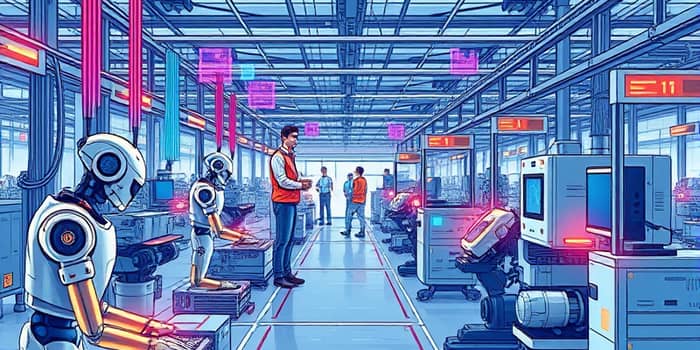
The manufacturing industry is undergoing a profound transformation as automation technologies surge ahead. With rising investments in robotics, AI, and IIoT solutions, factories around the world are redefining productivity benchmarks and operational standards. Companies large and small are racing to integrate intelligent systems that can boost efficiency, deliver superior quality, and respond to market demands with unprecedented agility. This article delves into the forces driving this shift, the tangible benefits realized today, and practical guidance for organizations ready to embrace the future of manufacturing.
The global industrial automation & control systems market is on a steep upward trajectory, expected to reach $226.8 billion in 2025—up from $206 billion in 2024, marking a projected compound annual growth rate of 10.8% through 2030. Meanwhile, the factory automation segment has seen consistent expansion since 2017, driven by both legacy manufacturers and emerging players seeking competitive edges. The AI in manufacturing market further exemplifies this growth, projected to climb from $5.94 billion in 2024 to $8.57 billion in 2025, with a bullish CAGR of 44.2% and a forecasted valuation of $68.36 billion by 2032.
Regionally, the Asia-Pacific region leads the charge, accounting for around 39% of global industrial automation revenue in 2024. North America, particularly the United States, remains a powerhouse in financial process automation and continues robust investments in manufacturing automation. The U.S. and India are standout adopters of AI-driven production, with 43% and 30% of manufacturing activity respectively powered by AI technologies.
Manufacturers today harness an eclectic mix of automation enablers. Robotic Process Automation (RPA) is set to reach $7.01 billion in market value by 2025, taking over repetitive administrative and operational tasks to free human workers for strategic challenges. The Industrial Internet of Things (IIoT) is connecting an estimated 36.8 billion devices by 2025, creating real-time data exchange capabilities that underpin predictive maintenance and dynamic scheduling.
Deep learning and AI integration enable smarter quality control systems that achieve up to 90% defect detection accuracy and boost product quality by 35%. Meanwhile, the rollout of 5G networks combined with edge computing provides the low-latency, high-reliability backbone needed for autonomous guided vehicles and fully connected smart factories. Together, these technologies form an ecosystem of interconnected intelligent manufacturing systems.
Adopting automation has delivered a suite of transformative advantages across the industry:
Despite these benefits, organizations must navigate potential pitfalls. Approximately 70% of digital transformation and automation projects fail to meet their intended objectives due to misaligned strategies, lack of clear governance, or inadequate change management. A short-term investment slowdown in 2024–2025 has further highlighted the importance of disciplined capital allocation and supply chain recalibration.
To succeed, companies should adopt a phased approach with rigorous pilot programs, detailed ROI assessments, and active stakeholder alignment. Building cross-functional teams that include IT, operations, and frontline staff can mitigate risks and accelerate adoption curves. Emphasizing continuous learning and agile methodologies also ensures that automation initiatives remain adaptable in volatile market conditions.
Automation’s influence on the labor market is complex but ultimately positive. While an estimated 92 million jobs may be displaced by 2030, automation-driven expansion is forecast to create 170 million new roles globally—a net gain of 78 million positions. This shift underscores the critical need for reskilling and upskilling programs. Employers must invest in comprehensive training to prepare teams for advanced manufacturing roles, including data analysis, robotics maintenance, and AI system oversight.
Small and medium manufacturers (SMMs) stand to benefit significantly as automation solutions become more accessible. By embracing modular, scalable technologies, SMMs can compete on quality and cost, driving growth in regional economies and fostering innovation hubs beyond traditional industrial centers.
Looking ahead, the manufacturing automation market is poised to resume robust growth after the current investment plateau. Continued digital transformation across supply chains, customization demands, and labor shortage pressures will serve as powerful tailwinds. Cutting-edge advancements in AI-driven process optimization, collaborative robotics, and digital twins will unlock new avenues for product innovation and operational excellence.
For organizations ready to embark on or accelerate their automation journey, the time to act is now. By aligning technology investments with strategic objectives, fostering a culture of learning, and engaging stakeholders at all levels, manufacturers can secure a competitive advantage. The era of intelligent factories is here, and those who move decisively will lead the next wave of industrial innovation.
Automation adoption accelerates in manufacturing sectors, ushering in an era of unprecedented efficiency, resiliency, and innovation. By leveraging data-driven technologies and fostering a forward-looking workforce, manufacturers can transform challenges into opportunities and shape the future of global industry.
References













